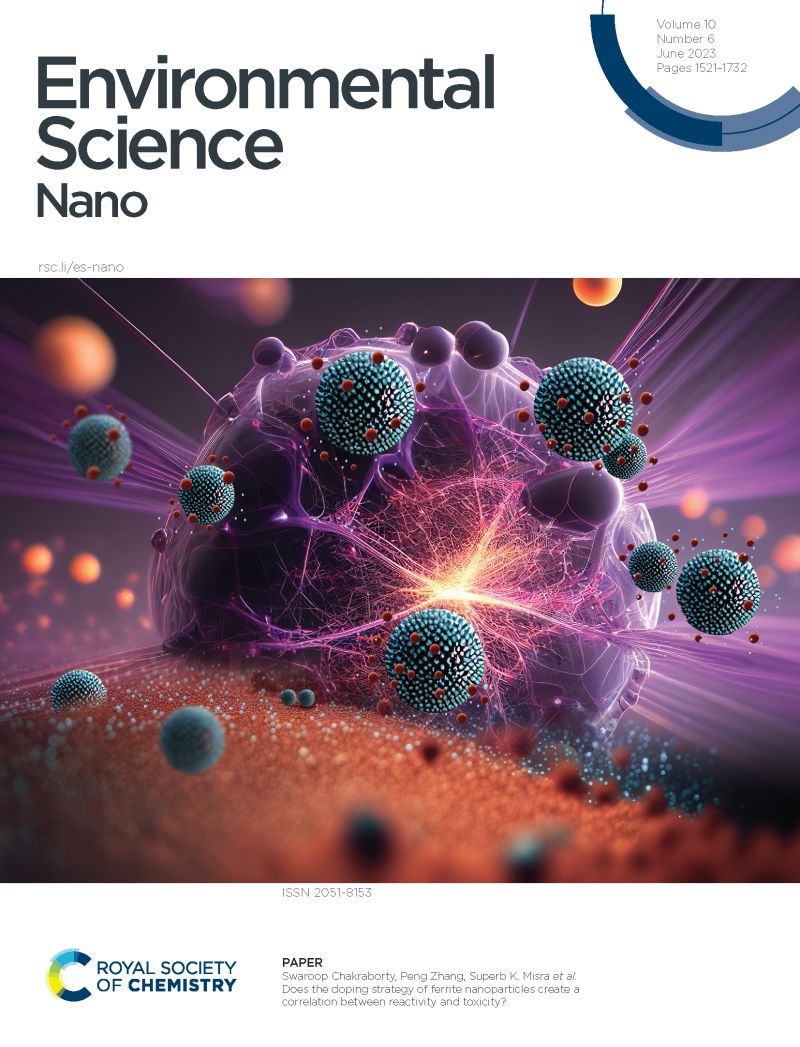Environmentally persistent free radicals readily form on TiO2 but not on ZnO nanoparticles
IF 5.8
2区 环境科学与生态学
Q1 CHEMISTRY, MULTIDISCIPLINARY
引用次数: 0
Abstract
Environmentally persistent free radicals (EPFRs) are stable organic radicals and pollutants in atmospheric and soil particles. Knowledge of EPFR formation on pristine, unsupported engineered nanoparticles is limited. This study investigates the potential of TiO2 and ZnO nanoparticles in aiding aromatic precursors in forming EPFRs and is an experimental verification of our earlier prediction on nanoparticles’ potential to form EPFRs. TiO2 formed EPFRs regardless of size, while ZnO exhibited size-dependent behavior. Only smaller ZnO particles readily produced EPFRs. Larger ZnO particles only formed EPFRs when pretreated with ethanol. EPFRs formed on TiO2 and ZnO near room temperature, challenging the belief that relatively high temperatures are needed for EPFRs to form. The yields of EPFRs on pristine TiO2 and ZnO were comparable to those found in atmospheric particulate matter. We identified four types of EPFRs: carbon-centered phenoxyl, oxygen-centered phenoxyl, carbon-centered semiquinone, and oxygen-centered semiquinone radicals. Our study suggests the role of band bending in forming EPFRs on TiO2 and ZnO, in which the adsorption of aromatic precursor acts as an electron acceptor or donor. Our findings suggest that EPFRs may form in unexpected places and conditions where TiO2 and ZnO nanoparticles are present.环境持久性自由基很容易在 TiO2 上形成,而在 ZnO 纳米粒子上则不然
环境持久性自由基 (EPFR) 是大气和土壤颗粒中稳定的有机自由基和污染物。人们对原始、无支撑的工程纳米粒子上 EPFR 的形成了解有限。本研究调查了 TiO2 和 ZnO 纳米粒子在帮助芳香族前体形成 EPFR 方面的潜力,并通过实验验证了我们之前对纳米粒子形成 EPFR 潜力的预测。无论尺寸大小,TiO2 都能形成 EPFR,而 ZnO 则表现出尺寸依赖性。只有较小的 ZnO 颗粒容易产生 EPFR。较大的氧化锌颗粒只有在用乙醇预处理时才会形成 EPFR。EPFR 在接近室温的二氧化钛和氧化锌上形成,这对认为 EPFR 的形成需要相对较高温度的观点提出了质疑。原始二氧化钛和氧化锌上的 EPFR 产量与大气颗粒物中的 EPFR 产量相当。我们发现了四种 EPFR:碳中心苯氧自由基、氧中心苯氧自由基、碳中心半醌自由基和氧中心半醌自由基。我们的研究表明,带弯曲在 TiO2 和 ZnO 上形成 EPFR 的过程中发挥了作用,其中芳香族前体的吸附起到了电子受体或供体的作用。我们的研究结果表明,EPFR 可能会在二氧化钛和氧化锌纳米粒子存在的意想不到的地方和条件下形成。
本文章由计算机程序翻译,如有差异,请以英文原文为准。
求助全文
约1分钟内获得全文
求助全文
来源期刊

Environmental Science: Nano
CHEMISTRY, MULTIDISCIPLINARY-ENVIRONMENTAL SCIENCES
CiteScore
12.20
自引率
5.50%
发文量
290
审稿时长
2.1 months
期刊介绍:
Environmental Science: Nano serves as a comprehensive and high-impact peer-reviewed source of information on the design and demonstration of engineered nanomaterials for environment-based applications. It also covers the interactions between engineered, natural, and incidental nanomaterials with biological and environmental systems. This scope includes, but is not limited to, the following topic areas:
Novel nanomaterial-based applications for water, air, soil, food, and energy sustainability
Nanomaterial interactions with biological systems and nanotoxicology
Environmental fate, reactivity, and transformations of nanoscale materials
Nanoscale processes in the environment
Sustainable nanotechnology including rational nanomaterial design, life cycle assessment, risk/benefit analysis
 求助内容:
求助内容: 应助结果提醒方式:
应助结果提醒方式:


